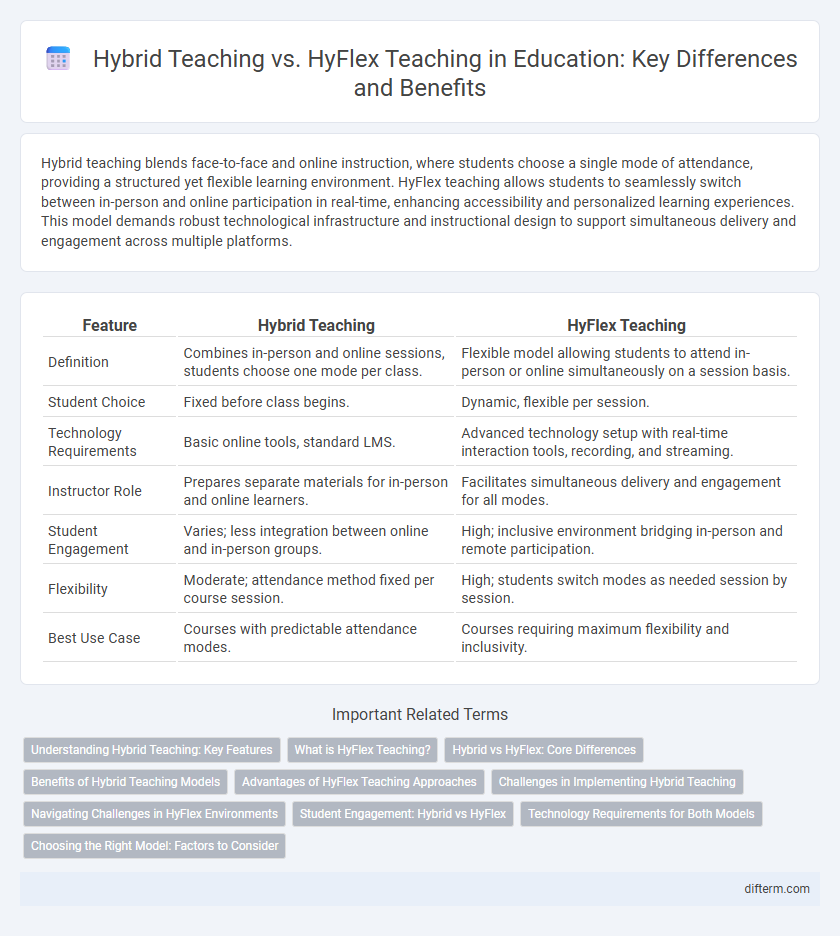Hybrid teaching blends face-to-face and online instruction, where students choose a single mode of attendance, providing a structured yet flexible learning environment. HyFlex teaching allows students to seamlessly switch between in-person and online participation in real-time, enhancing accessibility and personalized learning experiences. This model demands robust technological infrastructure and instructional design to support simultaneous delivery and engagement across multiple platforms.
Table of Comparison
| Feature | Hybrid Teaching | HyFlex Teaching |
|---|---|---|
| Definition | Combines in-person and online sessions, students choose one mode per class. | Flexible model allowing students to attend in-person or online simultaneously on a session basis. |
| Student Choice | Fixed before class begins. | Dynamic, flexible per session. |
| Technology Requirements | Basic online tools, standard LMS. | Advanced technology setup with real-time interaction tools, recording, and streaming. |
| Instructor Role | Prepares separate materials for in-person and online learners. | Facilitates simultaneous delivery and engagement for all modes. |
| Student Engagement | Varies; less integration between online and in-person groups. | High; inclusive environment bridging in-person and remote participation. |
| Flexibility | Moderate; attendance method fixed per course session. | High; students switch modes as needed session by session. |
| Best Use Case | Courses with predictable attendance modes. | Courses requiring maximum flexibility and inclusivity. |
Understanding Hybrid Teaching: Key Features
Hybrid teaching combines traditional face-to-face instruction with online learning components, allowing students to participate in class both in-person and remotely. It features scheduled sessions where some students attend physically while others join virtually, requiring synchronized delivery of content and interaction. Effective hybrid teaching relies on robust technology infrastructure, flexible curriculum design, and active engagement strategies to ensure equitable learning experiences for all students.
What is HyFlex Teaching?
HyFlex teaching is a flexible instructional model that combines in-person and online learning, allowing students to choose how they participate each class session. This approach supports synchronous engagement for both remote and on-campus learners through integrated technology platforms. By accommodating diverse learning preferences and schedules, HyFlex teaching enhances accessibility and student-centered education.
Hybrid vs HyFlex: Core Differences
Hybrid teaching combines in-person and online students, typically with a fixed schedule separating physical and virtual attendance. HyFlex teaching offers flexible options, allowing students to choose daily between in-person, synchronous online, or asynchronous participation. The core difference lies in HyFlex's emphasis on learner autonomy and real-time adaptability versus hybrid's predetermined, segmented modes of delivery.
Benefits of Hybrid Teaching Models
Hybrid teaching models combine in-person and online instruction, enhancing accessibility for diverse student populations and enabling flexible learning schedules. This approach improves student engagement by offering multiple modalities tailored to individual learning preferences, fostering better retention and skill development. Institutions benefit from optimized resource allocation and the ability to maintain instructional continuity during disruptions.
Advantages of HyFlex Teaching Approaches
HyFlex teaching approaches offer unparalleled flexibility by allowing students to choose between in-person and online participation, enhancing accessibility and engagement. This model supports diverse learning styles and schedules, promoting inclusivity and fostering higher student retention rates. Institutions benefit from increased scalability and adaptability, providing seamless transitions between modalities in response to changing circumstances.
Challenges in Implementing Hybrid Teaching
Hybrid teaching faces challenges such as ensuring equitable student engagement between in-person and remote learners, managing technology integration, and maintaining consistent instructional quality across different environments. Educators must address technical issues like unstable internet connections and inadequate digital tools that hinder seamless participation. Balancing real-time interaction and adapting assessment methods also complicate the effective implementation of hybrid teaching models.
Navigating Challenges in HyFlex Environments
Hybrid teaching combines in-person and online instruction with fixed schedules, while HyFlex teaching allows students to choose between participation modes each session, creating dynamic learning environments. Navigating challenges in HyFlex environments requires robust technology infrastructure, instructor flexibility, and clear communication strategies to ensure equitable engagement across all student modalities. Effective management of real-time interactions and asynchronous content integration enhances learning outcomes and addresses diverse learner needs.
Student Engagement: Hybrid vs HyFlex
Student engagement in hybrid teaching often fluctuates due to fixed schedules dividing in-person and remote learners, which can lead to uneven participation and limited interaction. HyFlex teaching enhances engagement by offering students the flexibility to choose between attending classes face-to-face, online synchronously, or asynchronously, thereby increasing accessibility and accommodating diverse learning preferences. This adaptability in HyFlex models promotes consistent interaction, higher motivation, and improved academic outcomes compared to traditional hybrid formats.
Technology Requirements for Both Models
Hybrid teaching requires reliable video conferencing tools, quality audio-visual equipment, and a stable internet connection to support both in-person and remote students synchronously. HyFlex teaching demands more advanced technology, including integrated learning management systems, interactive platforms for real-time engagement, and versatile hardware that accommodates seamless switching between face-to-face and multiple online participation modes. Robust tech infrastructure and user-friendly software are critical for both models to ensure effective communication, content delivery, and student interaction across diverse learning environments.
Choosing the Right Model: Factors to Consider
Choosing the right model between hybrid teaching and HyFlex teaching depends on factors such as student accessibility, technological infrastructure, and instructional flexibility. Hybrid teaching typically requires students to attend either in-person or online sessions on scheduled days, while HyFlex allows simultaneous participation both in-person and remotely, catering to diverse learning preferences. Assessing institutional resources, faculty readiness, and student needs is crucial to select the model that enhances engagement and learning outcomes effectively.
hybrid teaching vs HyFlex teaching Infographic

 difterm.com
difterm.com